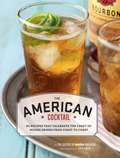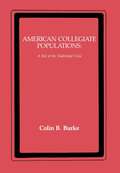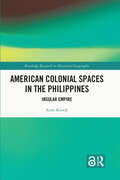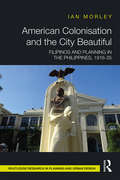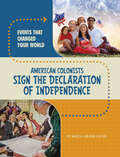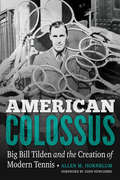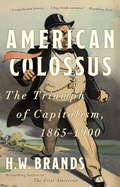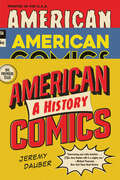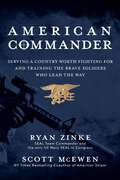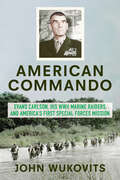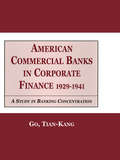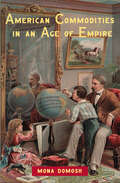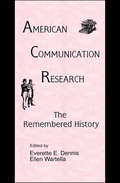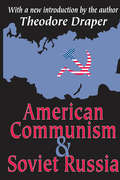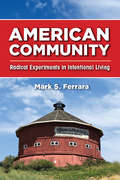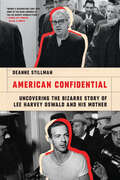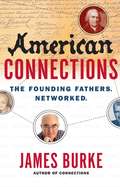- Table View
- List View
American Cocktail
by George Hutchinson Anita Reynolds Howard M. MillerThis is the rollicking, never-before-published memoir of a fascinating woman with an uncanny knack for being in the right place in the most interesting times. Of racially mixed heritage, Anita Reynolds was proudly African American but often passed for Indian, Mexican, or Creole. Actress, dancer, model, literary critic, psychologist, but above all free-spirited provocateur, she was, as her Parisian friends nicknamed her, an "American cocktail. " One of the first black stars of the silent era, she appeared in Hollywood movies with Rudolph Valentino, attended Charlie Chaplin's anarchist meetings, and studied dance with Ruth St. Denis. She moved to New York in the 1920s and made a splash with both Harlem Renaissance elites and Greenwich Village bohemians. An emigre in Paris, she fell in with the Left Bank avant garde, " befriending Antonin Artaud, Man Ray, and Pablo Picasso. Next, she took up residence as a journalist in Barcelona during the Spanish Civil War and witnessed firsthand the growing menace of fascism. In 1940, as the Nazi panzers closed in on Paris, Reynolds spent the final days before the French capitulation as a Red Cross nurse, afterward making a mad dash for Lisbon to escape on the last ship departing Europe. In prose that perfectly captures the globetrotting nonchalance of its author, American Cocktail" presents a stimulating, unforgettable self-portrait of a truly extraordinary woman.
American Cocktail
by Sheri Giblin Editors of Imbibe MagazineFrance has wine, Germany's got beer, but America is the land of the cocktail. And cocktail culture is flourishing with bartenders across America combining local, artisanal, and homemade ingredients to create drinks with complex layers of flavor. From the editors of Imbibe Magazine comes this unique book filled with 50 favorites from some of the best bartenders coast to coast offering modern twists on classic drinks, plus all-new creations, complete with a look into each recipe's inception and unique ingredients. Whether it's a marionberry bramble from Jeffrey Morgenthaler in Portland, Oregon, or a strawberry julep from Jenni Pittman Louisville, Kentucky, or an apple-based cocktail from Jim Meehan in New York City, the cocktails that define the American landscape are deliciously diverse. Consider this book your personal cross-country tour of America's most intriguing regional cocktail flavors, traditions and stories.
American College Presidency as Vocation: Easing the Burden, Enhancing the Joy
by William V. FrameAn engaging report on the Lilly Endowment-supported program on Presidential Vocation and Institutional Mission, led by the Council of Independent Colleges since 2005, showing the impact of the program upon the conception and practice of the American college and university presidency.
American Collegiate Populations: A Test of the Traditional View
by Colin BurkeAmerican Collegiate Populations is an exhaustive and definitive study of the membership of American colleges and universities in the nineteenth century. Colin B. Burke explores the questions of who went, who stayed and where they came from, presenting as answers to these questions a mass of new data put together in an original and interpretive manner.The author offers a devastating critique of the two reference works which until now have commanded scholars' attention. Burke examines Bailey Burritt's Professional Distribution of College and University Undergraduates (1912) noting that Burritt's categories oversimplify the data of the 37 institutions he studies. Donald G. Tewksbury's American Colleges and Universities Before the Civil War (1932), the author explains, presents a skewed interpretation of collegiate decline in the antebellum period. Using a far larger data base and capitalizing on the advances in quantitative history made in the last decade, Burke adopts appropriate analytic categories for college students and their subsequent careers. Amierican Collegiate Populations thus becomes the referent work to replace Burritt and Tewksbury and will likely have an equal longevity in print.American Collegiate Populations systematically compares denominational colleges, colleges by region, and student groups from a host of angles - age entering college, geographical origins, parental occupations. subsequent careers, and professional choices. Burke shows the reach of American colleges back into the socio-economic fabric of the culture. a reach that carries implications for many subjects - religious, economic, social, and intellectual - beyond the mere subject of college alone.Few works force the re-thinking of a whole field of historical inquiry - particularly one that has important bearings on current policy - as Burke's study does. The findings and implications presented in American Collegiate Populations will profoundly affect the scholarly community for decades to come.
American Colonial Spaces in the Philippines: Insular Empire (Routledge Research in Historical Geography)
by Scott KirschAmerican Colonial Spaces in the Philippines tells the story of U.S. colonialists who attempted, in the first decades of the twentieth century, to build an enduring American empire in the Philippines through the production of space. From concrete interventions in infrastructure, urban planning, and built environments to more abstract projects of mapping and territorialization, the book traces the efforts of U.S. Insular Government agents to make space for empire in the Philippines through forms of territory, map, landscape, and road, and how these spaces were understood as solutions to problems of colonial rule. Through the lens of space, the book offers an original history of a highly transformative, but largely misunderstood or forgotten, imperial moment, when the Philippine archipelago, made up of thousands of islands and an ethnically and religiously diverse population of more than seven million, became the unlikely primary setting for U.S. experimentation with formal colonial governance. Telling that story around key figures including Cameron Forbes, Daniel Burnham, Dean Worcester, and William Howard Taft, the book provides distinctive chapters dedicated to spaces of territory (sovereignty), maps (knowledge), landscape (aesthetics), and roads (circulation), suggesting new and integrative historical geographical approaches. This book will be of interest to students of Cultural, Historical, and Political Geography, American History, American Studies, Philippine Studies, Southeast Asia/Philippines; Asian Studies as well as general readers interested in these areas.
American Colonial Spaces in the Philippines: Insular Empire (Routledge Research in Historical Geography)
by Scott KirschAmerican Colonial Spaces in the Philippines tells the story of U.S. colonialists who attempted, in the first decades of the twentieth century, to build an enduring American empire in the Philippines through the production of space. From concrete interventions in infrastructure, urban planning, and built environments to more abstract projects of mapping and territorialization, the book traces the efforts of U.S. Insular Government agents to make space for empire in the Philippines through forms of territory, map, landscape, and road, and how these spaces were understood as solutions to problems of colonial rule.Through the lens of space, the book offers an original history of a highly transformative, but largely misunderstood or forgotten, imperial moment, when the Philippine archipelago, made up of thousands of islands and an ethnically and religiously diverse population of more than seven million, became the unlikely primary setting for U.S. experimentation with formal colonial governance. Telling that story around key figures including Cameron Forbes, Daniel Burnham, Dean Worcester, and William Howard Taft, the book provides distinctive chapters dedicated to spaces of territory (sovereignty), maps (knowledge), landscape (aesthetics), and roads (circulation), suggesting new and integrative historical geographical approaches.This book will be of interest to students of Cultural, Historical, and Political Geography, American History, American Studies, Philippine Studies, Southeast Asia/Philippines; Asian Studies as well as general readers interested in these areas.The Open Access version of this book, available at http://www.taylorfrancis.com, has been made available under a Creative Commons [Attribution-Non Commercial-No Derivatives (CC BY-NC-ND)] 4.0 license.
American Colonies
by Alan TaylorWith this volume, Alan Taylor challenges the traditional story of colonial history by examining the many cultures that helped make America. Transcending the usual Anglocentric version of our colonial past, he recovers the importance of Native American tribes, African slaves, and the rival empires of France, Spain, the Netherlands, and even Russia in the colonization of North America. Moving beyond the Atlantic seaboard to examine the entire continent, American Colonies reveals a pivotal period in the global interaction of peoples, cultures, plants, animals, and microbes. In a vivid narrative, Taylor draws upon cutting-edge scholarship to create a timely picture of the colonial world characterized by an interplay of freedom and slavery, opportunity and loss. .
American Colonies
by Alan TaylorWith this volume, Alan Taylor challenges the traditional story of colonial history by examining the many cultures that helped make America. Transcending the usual Anglocentric version of our colonial past, he recovers the importance of Native American tribes, African slaves, and the rival empires of France, Spain, the Netherlands, and even Russia in the colonization of North America. Moving beyond the Atlantic seaboard to examine the entire continent, American Colonies reveals a pivotal period in the global interaction of peoples, cultures, plants, animals, and microbes. In a vivid narrative, Taylor draws upon cutting-edge scholarship to create a timely picture of the colonial world characterized by an interplay of freedom and slavery, opportunity and loss.
American Colonisation and the City Beautiful: Filipinos and Planning in the Philippines, 1916-35
by Ian MorleyAmerican Colonisation and the City Beautiful explores the history of city planning and the evolution of the built environment in the Philippines between 1916 and 1935. In so doing, it highlights the activities of the Bureau of Public Works’ Division of Architecture as part of Philippine national development and decolonisation. Morley provides new archival materials which deliver significant insight into the dynamics associated with both governance and city planning during the American colonial era in the Philippines, with links between prominent American university educators and Filipino architecture students. The book discusses the two cities of Tayabas and Iloilo which highlight the significant role in the urban design of places beyond the typical historiographical focus of Manila and Baguio. These examples will aid in further understanding the appearance and meaning of Philippine cities during an important era in the nation’s history. Including numerous black and white images, this book is essential for academics, researchers and students of city and urban planning, the history and development of Southeast Asia and those interested in colonial relations.
American Colonists Sign the Declaration of Independence (Events That Changed Your World Ser.)
by Marcia Amidon LustedThe United States is a young country founded on complicated ideals—ones that it still strives to fulfill. Many of those ideals were established in the 1776 Declaration of Independence—when colonists decided to separate from Great Britain. With historical images and details about key events before and after the political separation, this book will help kids understand the impact of the declaration on the history of the United States. Uncover the details of events that changed your world in this Pebble Explore series.
American Colossus: Big Bill Tilden and the Creation of Modern Tennis
by Allen M. Hornblum John NewcombeBabe Ruth, Jack Dempsey, Bobby Jones, and Bill Tilden were the legendary quartet of the “Golden Age of Sports” in the 1920s. They transformed their respective athletic disciplines and captured the imagination of a nation. The indisputable force behind the emergence of professional tennis as a popular and lucrative sport, Tilden’s on-court accomplishments are nothing short of staggering. The first American‑born player to win Wimbledon and a seven‑time winner of the U.S. singles championship, he was the number 1 ranked player for ten straight years. A tall, flamboyant player with a striking appearance, Tilden didn’t just play; he performed with a singular style that separated him from other top athletes. Tilden was a showman off the court as well. He appeared in numerous comedies and dramas on both stage and screen and was a Renaissance man who wrote more than two dozen fiction and nonfiction books, including several successful tennis instructions books. But Tilden had a secret—one he didn’t fully understand himself. After he left competitive tennis in the late 1940s, he faced a lurid fall from grace when he was arrested after an incident involving an underage boy in his car. Tilden served seven months in prison and later attempted to explain his questionable behavior to the public, only to be ostracized from the tennis circuit. Despite his glorious career in tennis, his final years were much constrained and lived amid considerable public shunning. Tilden’s athletic accomplishments remain, as he is arguably the best American player ever. American Colossus is a thorough account of his life, bringing a much-needed look back at one of the world’s greatest athletes and a person whose story is as relevant as ever.
American Colossus: The Triumph of Capitalism, 1865-1900
by H. W. BrandsFrom the two-time Pulitzer Prize finalist, bestselling historian, and author of Our First Civil War: a "first-rate" narrative history (The New York Times) that brilliantly portrays the emergence, in a remarkably short time, of a recognizably modern America. American Colossus captures the decades between the Civil War and the turn of the twentieth century, when a few breathtakingly wealthy businessmen transformed the United States from an agrarian economy to a world power. From the first Pennsylvania oil gushers to the rise of Chicago skyscrapers, this spellbinding narrative shows how men like Morgan, Carnegie, and Rockefeller ushered in a new era of unbridled capitalism. In the end America achieved unimaginable wealth, but not without cost to its traditional democratic values.
American Comics: A History
by Jeremy DauberThe sweeping story of cartoons, comic strips, and graphic novels and their hold on the American imagination. Comics have conquered America. From our multiplexes, where Marvel and DC movies reign supreme, to our television screens, where comics-based shows like The Walking Dead have become among the most popular in cable history, to convention halls, best-seller lists, Pulitzer Prize–winning titles, and MacArthur Fellowship recipients, comics shape American culture, in ways high and low, superficial, and deeply profound. In American Comics, Columbia professor Jeremy Dauber takes readers through their incredible but little-known history, starting with the Civil War and cartoonist Thomas Nast, creator of the lasting and iconic images of Uncle Sam and Santa Claus; the golden age of newspaper comic strips and the first great superhero boom; the moral panic of the Eisenhower era, the Marvel Comics revolution, and the underground comix movement of the 1960s and ’70s; and finally into the twenty-first century, taking in the grim and gritty Dark Knights and Watchmen alongside the brilliant rise of the graphic novel by acclaimed practitioners like Art Spiegelman and Alison Bechdel. Dauber’s story shows not only how comics have changed over the decades but how American politics and culture have changed them. Throughout, he describes the origins of beloved comics, champions neglected masterpieces, and argues that we can understand how America sees itself through whose stories comics tell. Striking and revelatory, American Comics is a rich chronicle of the last 150 years of American history through the lens of its comic strips, political cartoons, superheroes, graphic novels, and more. FEATURING… • American Splendor • Archie • The Avengers • Kyle Baker • Batman • C. C. Beck • Black Panther • Captain America • Roz Chast • Walt Disney • Will Eisner • Neil Gaiman • Bill Gaines • Bill Griffith • Harley Quinn • Jack Kirby • Denis Kitchen • Krazy Kat • Harvey Kurtzman • Stan Lee • Little Orphan Annie • Maus • Frank Miller • Alan Moore • Mutt and Jeff • Gary Panter • Peanuts • Dav Pilkey • Gail Simone • Spider-Man • Superman • Dick Tracy • Wonder Wart-Hog • Wonder Woman • The Yellow Kid • Zap Comix … AND MANY MORE OF YOUR FAVORITES!
American Commander: Serving a Country Worth Fighting For and Training the Brave Soldiers Who Lead the Way
by Ryan ZinkeIn recent years, the world has learned just what is required to bravely serve America through the navy&’s most elite SEAL Team. Now, for the first time, we hear from their commander.For more than half a decade, Ryan Zinke was a commander at the most elite SEAL unit. A 23-year veteran of the US Navy SEALs, Zinke is a decorated officer and earned two Bronze Stars as the acting commander of Joint Special Forces in Iraq. Zinke trained and commanded many of the men who would one day run the covert operations to hunt down Osama bin Laden and save Captain Phillips (Maersk Alabama). He also served as mentor to now famous SEALs Marcus Luttrell (Lone Survivor) and Chris Kyle (American Sniper).Written with #1 New York Times bestselling co-author of American Sniper, Scott McEwen, American Commander will offer readers the hard-hitting, no-nonsense style the SEALs are known for.When Zinke signs with the US Navy he turns his sights on joining the ranks of the most elite fighting force, the SEALs. He eventually reaches the top of the SEAL Teams as an assault team commander. Zinke shares what it takes to train and motivate the most celebrated group of warriors on earth and then send them into harm&’s way. Through it, he shares his proven problem-solving approach: Situation, Mission, Execution, Command and Control, and Logistics.American Commander also covers Zinke&’s experience in running for Montana&’s sole seat in the United States Congress. Zinke&’s passion for his country shines as he conveys his vision to revitalize American exceptionalism. Scott McEwen and Ryan Zinke take readers behind the scenes and into the heart of America&’s most-feared fighting force. American Commander will inspire a new generation of leaders charged with restoring a bright future for our children&’s children.
American Commando
by John WukovitsBefore the Green Berets. . . Before the Navy SEALs. . . Before the Army Rangers. . . There was the Long Patrol. November 1942: in the hellish combat zone of Guadalcanal, one man would make history. Lt. Col. Evans Carlson was considered a maverick by many of his comrades-and an outright traitor by others. He spent years observing guerrilla tactics all over the world, and knew that those tactics could be used effectively by the Marines. Carlson and an elite fighting force-the 2nd Raider Battalion-embarked upon a thirty-day mission behind enemy lines where they disrupted Japanese supplies, inflicted a string of defeats on the enemy in open combat, and gathered invaluable intelligence on Japanese operations on Guadalcanal. And in the process they laid the foundation for every branch of Special Forces in the modern military. Here, for the first time, is a riveting account of one man, one battalion, and one mission that would forever change the ways of warfare. .
American Commercial Banks in Corporate Finance, 1929-1941: A Study in Banking Concentrations (Garland Studies In The Financial Sector Of The Economy)
by Go Kang TiaFirst published in 1999. Routledge is an imprint of Taylor & Francis, an informa company.
American Commodities in an Age of Empire
by Mona DomoshThis is a novel interpretation of the relationship between consumerism, commercialism, and imperialism during the first empire building era of America in the late nineteenth and early twentieth centuries. Unlike other empires in history, which were typically built on military power, the first American empire was primarily a commercial one
American Communication Research: The Remembered History (Routledge Communication Series)
by Ellen Wartella Everette E. DennisThis book captures the essence of a never-to-be-repeated glimpse at the history of media research. It offers a unique examination of the origins, meaning, and impact of media and communication research in America, with links to European antecedents. Based on a high-level seminar series at Columbia University's Freedom Forum Media Studies Center, the book features work by leading scholars, researchers, and media executives. Participants in the series have called the program "heroic and unprecedented." The book encompasses essays, commentaries, and reports by such leading figures as William McGuire, Elihu Katz, and Leo Bogart, plus posthumous reports by Wilbur Schramm, Malcolm Beville, and Hilde Himmelweit. It also contains original insights on the collaboration of Frank Stanton, Paul Lazarfeld, and Robert K. Merton.
American Communism and Soviet Russia
by Theodore DraperThis companion volume to The Roots of American Communism brings to completion what the author describes as the essence of the relationship of American Communism to Soviet Russia in the fi rst decade after the Bolsheviks seized power. The outpouring of new archive materials makes it plain that Draper's premise is direct and to the point: The communist movement "was transformed from a new expression of American radicalism to the American appendage of a Russian revolutionary power." Each generation must fi nd this out for itself, and no better guide exists than the work of master historian Theodore Draper. American Communism and Soviet Russia is acknowledged to be the classic, authoritative history of the critical formative period of the American Communist Party. Based on confi dential minutes of the top party committees, interviews with party leaders, and public records, this book carefully documents the infl uence of the Soviet Union on the fundamental nature of American Communism. Draper's refl ections on that period in this edition are a fi tting capstone to this pioneering effort. Daniel Bell, in Saturday Review, remarked about this work that "there are surprisingly few scholarly histories of individual Communist parties and even fewer which treat of this crucial decade in intimate detail. Draper's account is therefore of great importance." Arthur M. Schlesinger, in The New York Times Book Review, says that "in reading Draper's closely packed pages, one hardly knows whether to marvel more at the detachment with which he examines the Communist movement, the patience with which he unravels the dreary and intricate struggles for power among the top leaders, or the intelligence with which he analyzes the interplay of factors determining the development of American Communism." And Michael Harrington, in Commonweal, asserted that Draper's book "will long be a defi nitive source volume and analysis of the Stalinization of American Communism."
American Community: Radical Experiments in Intentional Living
by Mark S. FerraraMainstream notions of the “American Dream” usually revolve around the ownership of private property, a house of one’s own. Yet for the past 400 years, a large number of Americans have dared to dream bigger and bolder, choosing to live in intentional communities that pooled resources, and they worked to ensure the well-being of all their members. American Community takes us inside forty of the most interesting intentional communities in the nation’s history, from the colonial era to the present day. You will learn about such little-known experiments in cooperative living as the Icarian communities, which took the utopian ideas expounded in a 1840 French novel and put them into practice, ultimately spreading to five states over fifty years. Plus, it covers more recent communities such as Arizona’s Arcosanti, designed by architect Paolo Soleri as a model for ecologically sustainable living. In this provocative and engaging book, Mark Ferrara guides readers through an array of intentional communities that boldly challenged capitalist economic arrangements in order to attain ideals of harmony, equality, and social justice. By shining a light on these forgotten histories, it shows that far from being foreign concepts, communitarianism and socialism have always been vital parts of the American experience.
American Confidential: Uncovering the Bizarre Story of Lee Harvey Oswald and his Mother
by Deanne Stillman"Deanne Stillman's American Confidential takes the familiar and makes it new - makes it thrilling. You won't believe this story; it resonates with deep American echoes." - Darin Strauss, author of Chang & Eng On the 60th anniversary of the JFK assassination, a critically acclaimed writer presents an astonishing new account of one of the 20th century's most notorious assassins, Lee Harvey Oswald—and the mother who raised him . . . Was Lee Harvey Oswald—as he himself claimed—a patsy? A hired gunman? In this startling account, Deanne Stillman suggests that there was indeed a conspiracy behind the assassination of John F. Kennedy—that of Oswald and his mother, Marguerite, who were locked in a desperate pursuit of fame and recognition. It was a struggle that would erupt on November 22, 1963, with Kennedy&’s murder—after which the assassin joined the roster of infamous immortals, while his mother spent the rest of her life seeking the media limelight. American Confidential is a mother-son noir tale that plays out across the Wild West of mid-twentieth century America, delving into Oswald&’s nomadic boyhood, and the world of his restless and disillusioned mother, who passed along a legacy of class resentment and a clamorous need to matter. In this new and surprising investigation into the short, troubled life of the ordinary man who would take down an American king, Deanne Stillman also presents a fascinating portrait of Oswald as a predecessor of the many violent young men and boys of America today, who take selfies with their rifles, and have come to define a new era of brutality. Following in the tradition of Joan Didion and Charles Bowden, and continuing her celebrated exploration of America&’s shadowlands, Stillman recounts a haunting tale of the promise and failure of the American dream. It held Oswald in its grip until the very end. &“Some day,&” he once told his wife, &“I&’d like to have a son. Maybe he&’ll grow up to be president.&”
American Congo: The African American Freedom Struggle in the Delta
by Nan Elizabeth WoodruffIn 1921, freedom fighter William Pickens described the Mississippi River Valley as the "American Congo. " Nan Woodruff argues that the African Congo under Belgium's King Leopold II is an apt metaphor for the Delta of the early twentieth century. Both wore the face of science, progressivism, and benevolence, yet were underwritten by brutal labor conditions, violence, and terror. As in the Congo, she argues, the Delta began with the promise of empire: U. S. capitalists on the lookout for new prospects cleared the vast Delta swamps. With the subsequent emergence of a wealthy planter class, the promise of untold riches, and a largely black labor force, America had its Congo. Woodruff chronicles the following half-century of individual and collective struggles as black sharecroppers fought to earn a just return for their labor, to live free from terror, to own property, to have equal access to the legal system, to move at will, and to vote. They fought for citizenship not only of men, but of women and families, and were empowered by the wars and upheavals of the time. Indeed, Woodruff argues, the civil rights movement cannot be adequately understood apart from these earlier battles for freedom.
American Connections: The Founding Fathers. Networked.
by James BurkeUsing the unique approach that he has employed in his previous books, author, columnist, and television commentator James Burke shows us our connections to the fifty-six men who signed the Declaration of Independence. Over the two hundred-plus years that separate us, these connections are often surprising and always fascinating. Burke turns the signers from historical icons into flesh-and-blood people: Some were shady financial manipulators, most were masterful political operators, a few were good human beings, and some were great men. The network that links them to us is also peopled by all sorts, from spies and assassins to lovers and adulterers, inventors and artists. The ties may be more direct for some of us than others, but we are all linked in some way to these founders of our nation. If you enjoyed Martin Sheen as the president on television's The West Wing, then you're connected to founder Josiah Bartlett. The connection from signer Bartlett to Sheen includes John Paul Jones; Judge William Cooper, father of James Fenimore; Sir Thomas Brisbane, governor of New South Wales; an incestuous astronomer; an itinerant math teacher; early inventors of television; and pioneering TV personality Bishop Fulton J. Sheen, the inspiration for Ramon Estevez's screen name, Martin Sheen.
American Connector Co. (A)
by Gary P. Pisano Sharon RossiAmerican Connector Co. is forced to reexamine operations at its Sunnyvale plant when a Japanese competitor announces plans to build an "ultimate" plant in the United States. Case examines issues related to benchmarking a competitor's manufacturing capabilities and productivity. Allows students to compare two companies' manufacturing strategies and their implications for productivity and flexibility.
American Connector Co. (B)
by Gary P. PisanoPresents a plant manager's proposal to improve operations at American Connector Co. The plan attempts to imitate operations at DJC Corp., a successful Japanese competitor. Requires students to consider how changes in manufacturing impact productivity, flexibility, and overall strategy.

